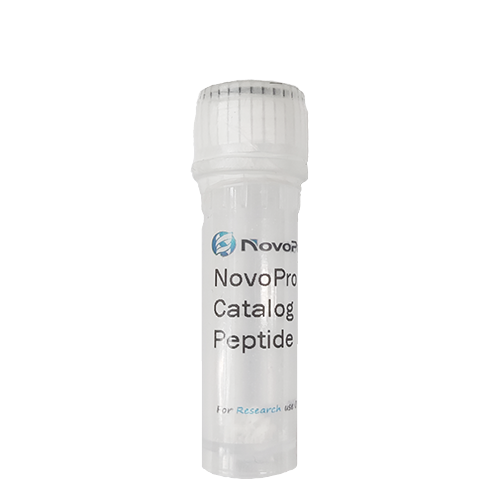β- Amyloid (1-16) peptide
Not For Human Use, Lab Use Only.
Cat.#: 301226
Special Price 202.40 USD
-
Product Name
β- Amyloid (1-16) peptide
-
Documents
Batch to batch variation of the purity
-
Sequence Shortening
DAEFRHDSGYEVHHQK
-
Sequence
Asp-Ala-Glu-Phe-Arg-His-Asp-Ser-Gly-Tyr-Glu-Val-His-His-Gln-Lys
-
Length (aa)
16
-
Peptide Purity (HPLC)
98%
-
Molecular Formula
C84H119N27O28
-
Molecular Weight
1955.05
-
CAS No.
131580-10-4
-
Source
Synthetic
-
Form
Powder
-
Description
The Cu²⁺ complex of this soluble amyloid β-protein fragment showed significant oxidative activities toward the catechol-like substrate 1,2,3-trihydroxylbenzene (pyrogallol) and plasmid DNA cleavage. The N-terminal Aβ fragments Aβ1-14 (H-7372), Aβ1-15 (H-6368), and Aβ1-16 are elevated in cell media and in CSF in response to γ-secretase inhibitor treatment.
-
Storage Guidelines
Normally, this peptide will be delivered in lyophilized form and should be stored in a freezer at or below -20 °C. For more details, please refer to the manual: Handling and Storage of Synthetic Peptides
-
About TFA salt
Trifluoroacetic acid (TFA) is a common counterion from the purification process using High-Performance Liquid Chromatography (HPLC). The presence of TFA can affect the peptide's net weight, appearance, and solubility.
Impact on Net Weight: The TFA salt contributes to the total mass of the product. In most cases, the peptide content constitutes >80% of the total weight, with TFA accounting for the remainder.
Solubility: TFA salts generally enhance the solubility of peptides in aqueous solutions.
In Biological Assays: For most standard in vitro assays, the residual TFA levels do not cause interference. However, for highly sensitive cellular or biochemical studies, please be aware of its presence.
-
Molar Concentration Calculator
-
Dilution Calculator
-
Percent Concentration Calculator
Mass (g) = Concentration (mol/L) × Volume (L) × Molecular Weight (g/mol)
Peptide Property
- Analysed Sequence:H-DAEFRHDSGYEVHHQK-OH
- Chemical Formula:C84H119N27O28
- Sequence length:16
- Extinction coefficient:1280 M-1cm-1
- GRAVY:-1.83
- Mw average:1955
- Theoretical pI:5.76
- Data Source:Peptide Property Calculator
GRAVY = grand average of hydropathy
X: Hydrophobic uncharged residues, like F I L M V W A and P
X: Basic residues, like R K H
X: Acidic residues, like D E
X: Polar uncharged residues, like G S T C N Q and Y
Related Products / Services
• Peptide Services: NovoPro's peptide synthesis services include standard chemical peptide synthesis, peptide modification, peptide libraries, and recombinant peptide expression.
• Standard Peptide Synthesis: NovoPro offers quality peptides at the most competitive prices in the industry, starting at $3.20 per amino acid. NovoPro provides PepBox – Automatic Quote Tool for online price calculation.
• Peptide Modifications: NovoPro offers a wide range of peptide modification services including isotope labeling (2H, 15N, and 13C), multiple disulfide bonds, multiple phosphorylations, KLH, BSA, ovalbumin, amidation, acetylation, biotin, FITC, etc.
Please note: All products are "FOR RESEARCH USE ONLY AND ARE NOT INTENDED FOR DIAGNOSTIC OR THERAPEUTIC USE"

